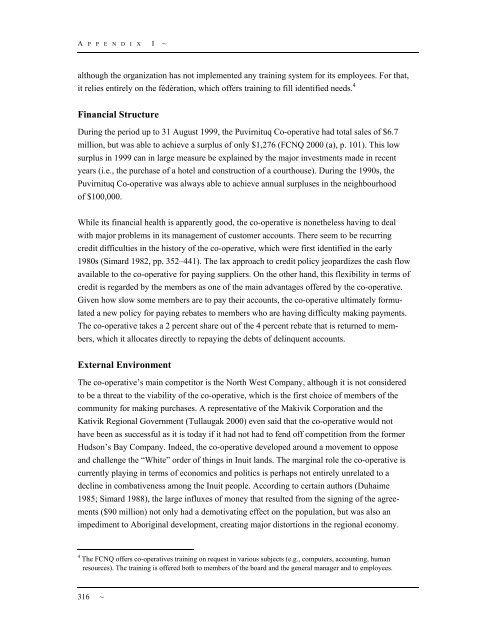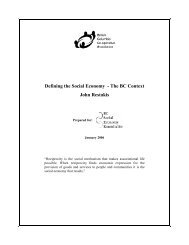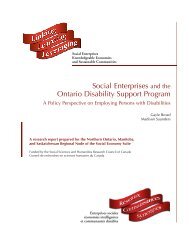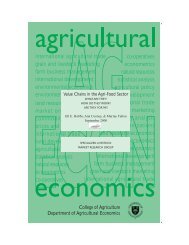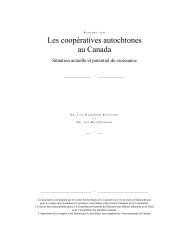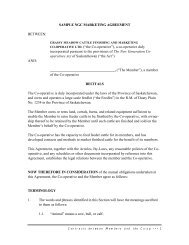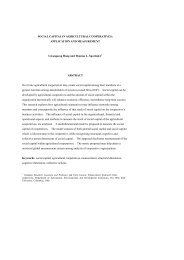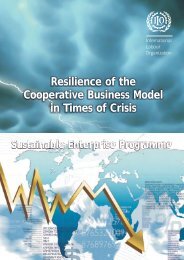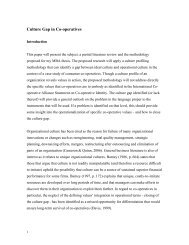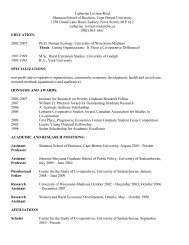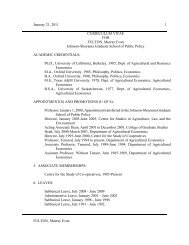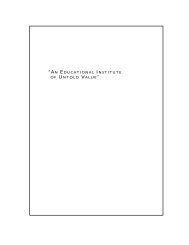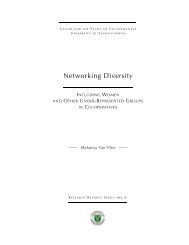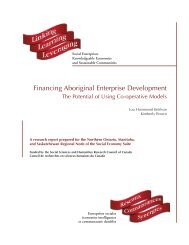Aboriginal Co-operatives in Canada - Centre for the Study of Co ...
Aboriginal Co-operatives in Canada - Centre for the Study of Co ...
Aboriginal Co-operatives in Canada - Centre for the Study of Co ...
Create successful ePaper yourself
Turn your PDF publications into a flip-book with our unique Google optimized e-Paper software.
A P P E N D I X I ~although <strong>the</strong> organization has not implemented any tra<strong>in</strong><strong>in</strong>g system <strong>for</strong> its employees. For that,it relies entirely on <strong>the</strong> fédération, which <strong>of</strong>fers tra<strong>in</strong><strong>in</strong>g to fill identified needs. 4F<strong>in</strong>ancial StructureDur<strong>in</strong>g <strong>the</strong> period up to 31 August 1999, <strong>the</strong> Puvirnituq <strong>Co</strong>-operative had total sales <strong>of</strong> $6.7million, but was able to achieve a surplus <strong>of</strong> only $1,276 (FCNQ 2000 (a), p. 101). This lowsurplus <strong>in</strong> 1999 can <strong>in</strong> large measure be expla<strong>in</strong>ed by <strong>the</strong> major <strong>in</strong>vestments made <strong>in</strong> recentyears (i.e., <strong>the</strong> purchase <strong>of</strong> a hotel and construction <strong>of</strong> a courthouse). Dur<strong>in</strong>g <strong>the</strong> 1990s, <strong>the</strong>Puvirnituq <strong>Co</strong>-operative was always able to achieve annual surpluses <strong>in</strong> <strong>the</strong> neighbourhood<strong>of</strong> $100,000.While its f<strong>in</strong>ancial health is apparently good, <strong>the</strong> co-operative is none<strong>the</strong>less hav<strong>in</strong>g to dealwith major problems <strong>in</strong> its management <strong>of</strong> customer accounts. There seem to be recurr<strong>in</strong>gcredit difficulties <strong>in</strong> <strong>the</strong> history <strong>of</strong> <strong>the</strong> co-operative, which were first identified <strong>in</strong> <strong>the</strong> early1980s (Simard 1982, pp. 352–441). The lax approach to credit policy jeopardizes <strong>the</strong> cash flowavailable to <strong>the</strong> co-operative <strong>for</strong> pay<strong>in</strong>g suppliers. On <strong>the</strong> o<strong>the</strong>r hand, this flexibility <strong>in</strong> terms <strong>of</strong>credit is regarded by <strong>the</strong> members as one <strong>of</strong> <strong>the</strong> ma<strong>in</strong> advantages <strong>of</strong>fered by <strong>the</strong> co-operative.Given how slow some members are to pay <strong>the</strong>ir accounts, <strong>the</strong> co-operative ultimately <strong>for</strong>mulateda new policy <strong>for</strong> pay<strong>in</strong>g rebates to members who are hav<strong>in</strong>g difficulty mak<strong>in</strong>g payments.The co-operative takes a 2 percent share out <strong>of</strong> <strong>the</strong> 4 percent rebate that is returned to members,which it allocates directly to repay<strong>in</strong>g <strong>the</strong> debts <strong>of</strong> del<strong>in</strong>quent accounts.External EnvironmentThe co-operative’s ma<strong>in</strong> competitor is <strong>the</strong> North West <strong>Co</strong>mpany, although it is not consideredto be a threat to <strong>the</strong> viability <strong>of</strong> <strong>the</strong> co-operative, which is <strong>the</strong> first choice <strong>of</strong> members <strong>of</strong> <strong>the</strong>community <strong>for</strong> mak<strong>in</strong>g purchases. A representative <strong>of</strong> <strong>the</strong> Makivik <strong>Co</strong>rporation and <strong>the</strong>Kativik Regional Government (Tullaugak 2000) even said that <strong>the</strong> co-operative would nothave been as successful as it is today if it had not had to fend <strong>of</strong>f competition from <strong>the</strong> <strong>for</strong>merHudson’s Bay <strong>Co</strong>mpany. Indeed, <strong>the</strong> co-operative developed around a movement to opposeand challenge <strong>the</strong> “White” order <strong>of</strong> th<strong>in</strong>gs <strong>in</strong> Inuit lands. The marg<strong>in</strong>al role <strong>the</strong> co-operative iscurrently play<strong>in</strong>g <strong>in</strong> terms <strong>of</strong> economics and politics is perhaps not entirely unrelated to adecl<strong>in</strong>e <strong>in</strong> combativeness among <strong>the</strong> Inuit people. Accord<strong>in</strong>g to certa<strong>in</strong> authors (Duhaime1985; Simard 1988), <strong>the</strong> large <strong>in</strong>fluxes <strong>of</strong> money that resulted from <strong>the</strong> sign<strong>in</strong>g <strong>of</strong> <strong>the</strong> agreements($90 million) not only had a demotivat<strong>in</strong>g effect on <strong>the</strong> population, but was also animpediment to <strong>Aborig<strong>in</strong>al</strong> development, creat<strong>in</strong>g major distortions <strong>in</strong> <strong>the</strong> regional economy.4 The FCNQ <strong>of</strong>fers co-<strong>operatives</strong> tra<strong>in</strong><strong>in</strong>g on request <strong>in</strong> various subjects (e.g., computers, account<strong>in</strong>g, humanresources). The tra<strong>in</strong><strong>in</strong>g is <strong>of</strong>fered both to members <strong>of</strong> <strong>the</strong> board and <strong>the</strong> general manager and to employees.316 ~


